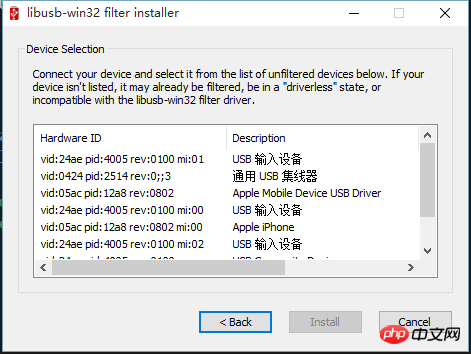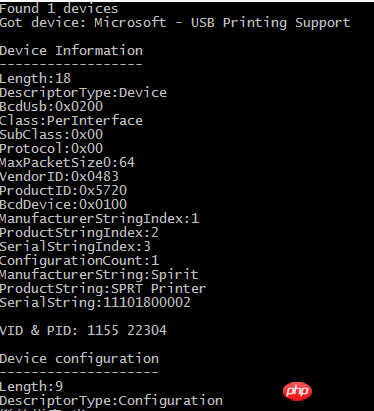 Backend Development
Backend Development
 C#.Net Tutorial
C#.Net Tutorial
 Detailed example of how to use LibUsbDotNet to implement USB communication in C#
Detailed example of how to use LibUsbDotNet to implement USB communication in C#
Detailed example of how to use LibUsbDotNet to implement USB communication in C#
There is relatively little information on C# USB communication on the Internet. They are basically based on LibUsbDotNet and CyUsb. There is also an OPOS about printer equipment.
This article is based on LibUsbDotNet.
1. Download and install the LibUsbDotNet installation file.
2. Run Filter Wizard, Install a device filter. Install the USB device that requires communication.

3. Build a simple console project and test it. The picture below shows the information required for printing communication equipment.

Related codes:
Quote
using LibUsbDotNet; using LibUsbDotNet.Main; using LibUsbDotNet.Info;
PrintUsbInfo
public static void PrintUsbInfo()
{
UsbDevice usbDevice = null;
UsbRegDeviceList allDevices = UsbDevice.AllDevices;
Console.WriteLine("Found {0} devices", allDevices.Count);
foreach (UsbRegistry usbRegistry in allDevices)
{
Console.WriteLine("Got device: {0}\r\n", usbRegistry.FullName);
if (usbRegistry.Open(out usbDevice))
{
Console.WriteLine("Device Information\r\n------------------");
Console.WriteLine("{0}", usbDevice.Info.ToString());
Console.WriteLine("VID & PID: {0} {1}", usbDevice.Info.Descriptor.VendorID, usbDevice.Info.Descriptor.ProductID);
Console.WriteLine("\r\nDevice configuration\r\n--------------------");
foreach (UsbConfigInfo usbConfigInfo in usbDevice.Configs)
{
Console.WriteLine("{0}", usbConfigInfo.ToString());
Console.WriteLine("\r\nDevice interface list\r\n---------------------");
ReadOnlyCollection<UsbInterfaceInfo> interfaceList = usbConfigInfo.InterfaceInfoList;
foreach (UsbInterfaceInfo usbInterfaceInfo in interfaceList)
{
Console.WriteLine("{0}", usbInterfaceInfo.ToString());
Console.WriteLine("\r\nDevice endpoint list\r\n--------------------");
ReadOnlyCollection<UsbEndpointInfo> endpointList = usbInterfaceInfo.EndpointInfoList;
foreach (UsbEndpointInfo usbEndpointInfo in endpointList)
{
Console.WriteLine("{0}", usbEndpointInfo.ToString());
}
}
}
usbDevice.Close();
}
Console.WriteLine("\r\n----- Device information finished -----\r\n");
}
}Call
public static void Main(string[] args)
{
PrintUsbInfo();
// Wait for user input..
Console.ReadKey();
}
The above is the detailed content of Detailed example of how to use LibUsbDotNet to implement USB communication in C#. For more information, please follow other related articles on the PHP Chinese website!

Hot AI Tools

Undresser.AI Undress
AI-powered app for creating realistic nude photos

AI Clothes Remover
Online AI tool for removing clothes from photos.

Undress AI Tool
Undress images for free

Clothoff.io
AI clothes remover

AI Hentai Generator
Generate AI Hentai for free.

Hot Article

Hot Tools

Notepad++7.3.1
Easy-to-use and free code editor

SublimeText3 Chinese version
Chinese version, very easy to use

Zend Studio 13.0.1
Powerful PHP integrated development environment

Dreamweaver CS6
Visual web development tools

SublimeText3 Mac version
God-level code editing software (SublimeText3)

Hot Topics
 .NET Deep Dive: Mastering Asynchronous Programming, LINQ, and EF Core
Mar 31, 2025 pm 04:07 PM
.NET Deep Dive: Mastering Asynchronous Programming, LINQ, and EF Core
Mar 31, 2025 pm 04:07 PM
The core concepts of .NET asynchronous programming, LINQ and EFCore are: 1. Asynchronous programming improves application responsiveness through async and await; 2. LINQ simplifies data query through unified syntax; 3. EFCore simplifies database operations through ORM.
 Advanced C# .NET: Concurrency, Parallelism, and Multithreading Explained
Apr 03, 2025 am 12:01 AM
Advanced C# .NET: Concurrency, Parallelism, and Multithreading Explained
Apr 03, 2025 am 12:01 AM
C#.NET provides powerful tools for concurrent, parallel and multithreaded programming. 1) Use the Thread class to create and manage threads, 2) The Task class provides more advanced abstraction, using thread pools to improve resource utilization, 3) implement parallel computing through Parallel.ForEach, 4) async/await and Task.WhenAll are used to obtain and process data in parallel, 5) avoid deadlocks, race conditions and thread leakage, 6) use thread pools and asynchronous programming to optimize performance.
 How to convert char in C language
Apr 03, 2025 pm 03:21 PM
How to convert char in C language
Apr 03, 2025 pm 03:21 PM
In C language, char type conversion can be directly converted to another type by: casting: using casting characters. Automatic type conversion: When one type of data can accommodate another type of value, the compiler automatically converts it.
 What is the role of char in C strings
Apr 03, 2025 pm 03:15 PM
What is the role of char in C strings
Apr 03, 2025 pm 03:15 PM
In C, the char type is used in strings: 1. Store a single character; 2. Use an array to represent a string and end with a null terminator; 3. Operate through a string operation function; 4. Read or output a string from the keyboard.
 How to use char array in C language
Apr 03, 2025 pm 03:24 PM
How to use char array in C language
Apr 03, 2025 pm 03:24 PM
The char array stores character sequences in C language and is declared as char array_name[size]. The access element is passed through the subscript operator, and the element ends with the null terminator '\0', which represents the end point of the string. The C language provides a variety of string manipulation functions, such as strlen(), strcpy(), strcat() and strcmp().
 What is the function of C language sum?
Apr 03, 2025 pm 02:21 PM
What is the function of C language sum?
Apr 03, 2025 pm 02:21 PM
There is no built-in sum function in C language, so it needs to be written by yourself. Sum can be achieved by traversing the array and accumulating elements: Loop version: Sum is calculated using for loop and array length. Pointer version: Use pointers to point to array elements, and efficient summing is achieved through self-increment pointers. Dynamically allocate array version: Dynamically allocate arrays and manage memory yourself, ensuring that allocated memory is freed to prevent memory leaks.
 How to handle special characters in C language
Apr 03, 2025 pm 03:18 PM
How to handle special characters in C language
Apr 03, 2025 pm 03:18 PM
In C language, special characters are processed through escape sequences, such as: \n represents line breaks. \t means tab character. Use escape sequences or character constants to represent special characters, such as char c = '\n'. Note that the backslash needs to be escaped twice. Different platforms and compilers may have different escape sequences, please consult the documentation.
 C# .NET Performance Optimization: Real-World Techniques for Faster Applications
Apr 02, 2025 pm 02:06 PM
C# .NET Performance Optimization: Real-World Techniques for Faster Applications
Apr 02, 2025 pm 02:06 PM
Methods to improve the performance of C#.NET applications include: 1. Optimize garbage collection (GC) by reducing object allocation and using array substitution lists; 2. Reasonable use of asynchronous programming to avoid blocking the main thread; 3. Optimize LINQ queries by avoiding method chains and using delayed execution; 4. Use parallel processing such as Parallel.For to improve the performance of complex scenarios; 5. Avoid common errors such as memory leaks and deadlocks, and use debugging tools to fix them.





